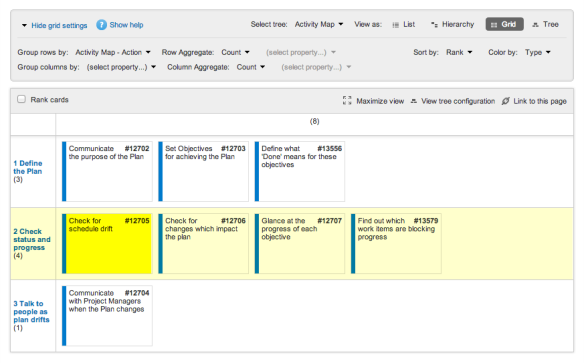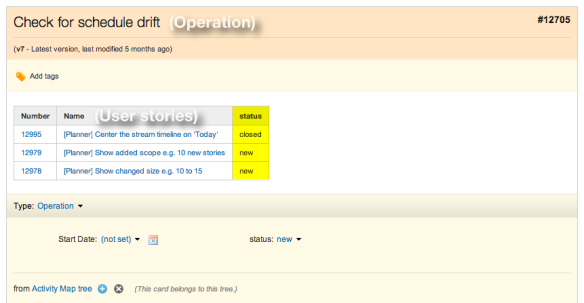
Keeping Track of Customer Value Deliverables
The purpose of the single user story gets lost in the flow of work
As most Agile and Kanban teams know, user stories can help teams collaborate around bite-sized chunks of work. The single, trackable user story allows teams to measure and sustain a constant flow of work. And yet, I have noticed that as teams become more proficient at establishing a flow, the usefulness of the user story as a way to communicate customer value diminishes severely.
As Jeff Patton says in The new user story is a backlog map:
Arranging user stories in the order you’ll build them doesn’t help me explain to others what the system does. Try handing your user story backlog to your stakeholders or users when they ask you the question “what does the system you’re building do?”
At the top of the [backlog] map are “big stories.” I call them user activities (borrowing the term from UX people like Larry Constantine and Don Norman). An activity is sort of a big thing that people do – something that has lots of steps, and doesn’t always have a precise workflow.
On my teams we have taken the idea of applying activity-centered design to the backlog and extended it to the entire product development cycle; end-to-end and continuously.
Activity maps help you track progress toward delivering customer value
Activity maps are a simple and lightweight artifact that help you track progress toward delivering customer value. Through the creation of an activity map, your team will create a precise and elegant lexicon that will sharpen your understanding about what you are trying accomplish.
- Activity: The most basic unit of analysis defined as any collaborative, goal-directed, and purposeful human endeavor
- Actions: Activities consist of a chain of actions that represent an immediate, specific, and conscious human goal
- Operations: Actions consist of a chain of operations that are habitual, automatic, and routinized
Simple, repeatable, and useful
Intentionally simple, activity maps may be re-purposed easily in digital and physical form. In Thoughtworks’ Mingle, activity maps can be set up in a matter of minutes. With added power from Mingle’s query language “MQL” you can easily track the progress of individual user stories in the context of their corresponding operations.

Activity, actions, and operations in Thoughtworks’ Mingle

Tracking user story progress in the context of an operation using Thoughtworks’ Mingle
Don’t make people do the grunt work
In activity theory, the operation is the smallest unit of analysis of an activity. Any analysis beyond the operational level will put you squarely in the realm of making people do grunt work, negating any intention of using technology to improve people’s lives.
My favorite example of how technology can remove menial work from our daily lives is the GPS feature found in Apple and Google’s map applications. When you want directions to a destination from your current location, you don’t have to know anything about your current location: No physical address. Nothing. It just works.
How do I get started making activity maps?
The best place to start is with your customers. Talk to as many as you can and as often as you can. It also helps to first understand your customer’s perspective through the lens of an activity system.
How do I know if I am doing it right?
It comes down to creating an elegant and precise language about the activity your product supports. For the activity, keep it high level yet meaningful. Remember, an activity is a purposeful human endeavor that is inherently social and outcome-focused.
Examples of activities:
- Following people and conversations (with Twitter)
- Keeping up with friends (with Facebook)
- Photo sharing (with Instagram)
For actions and operations, avoid using terms like manage, create, document, and user. Instead, combine meaningful verbs and nouns such as “get directions”, “invite friends”, and “take a picture”.
Further Reading
The new user story backlog is a map
Activity Theory: Basic Concepts and Applications
Story Mapper by Carbon Five
Disclaimer: The statements and opinions expressed in this article are those of the author(s) and do not necessarily reflect the positions of Thoughtworks.














